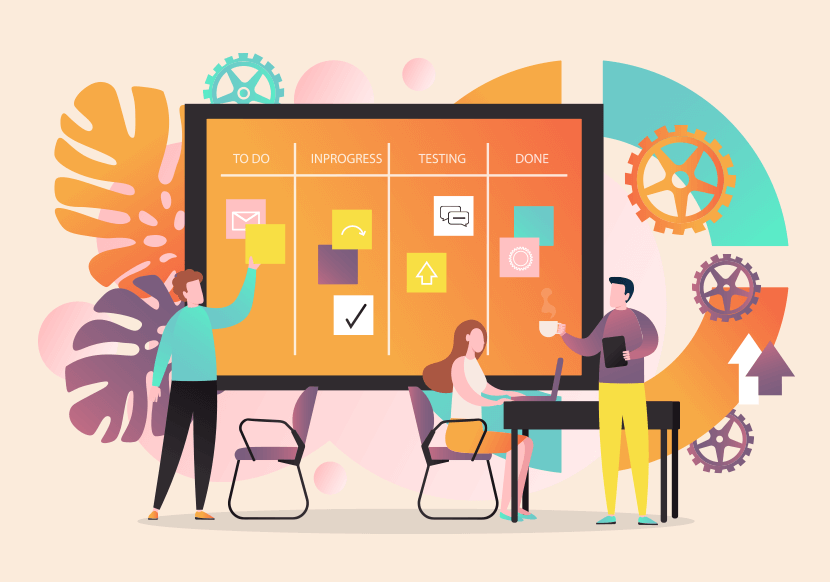By Mrugesh Panchal,

Today’s software development teams rely on modern structures like agile methodology to deliver outstanding results on consistently. And kanban development is one approach that has made it easy for software teams to adopt agile on-the-go.
Here, we are going to break the mighty question, what is kanban into an easy-to-understand guide for you.
What is Kanban?
Kanban is an agile framework used by software development teams to organise their workflow. The framework focuses on a real-time balance between work in progress (WIP) and capacity to help teams deliver products efficiently at an optimal speed.
A Brief History of Kanban

Kanban, which means “Visual Signal” in Japanese, is a concept that works on the principle of just-in-time (JIT) production. It enables you to devise a system that tells you what to produce, when to produce it, and how much to produce.
Around 1940, Toyota started implementing this practice to optimise operations of manufacturing and logistic units. Toyota established a communication cycle between production team, warehouse, and suppliers to keep the check on actual material requirement using a card (or a kanban).
When a specific material is consumed on the floor, the production team would mention the details of consumed material on the card and send it to the warehouse. After sending the exact amount of material to the production team, warehouse team would pass on the card to the supplier to send the stock of consumed material. With this just-in-time production control system, Toyota achieved enhanced productivity while reducing the cost-intensive inventory of raw materials, semi-finished materials, and finished products.
In early 2000, David J. Anderson reimagined this visual signalling method for software development. Since then, kanban is the most popular framework adopted by software teams to implement the agile methodology.
Kanban for Software Development

Kanban adopted by the software teams is very close to the game of a relay race, where a race track is usually divided into four stages. A runner starts running in a marked exchange zone. After completing a stage, the runner passes a stick-like object called baton to the next runner. Their goal is to get the baton across the finishing line in the shortest time possible. It’s a sequential team effort, as the performance of each runner would influence or impact the performance of the next runner and the outcome. Therefore, each runner of the team must support each other and give their best to win the race.
Here, imagine the race track as a kanban board where team sticks the kanbancards (baton) that carry the task details or user stories. As the team completes tasks in different steps of the development cycle, kanban cards move from one stage to other, finally ending its journey in the ‘Done’ stage.
You would need a deck of stickies, a board, and a simple understanding of workflow to kick-start your kanban team. It’s the biggest plus point of kanban that you can start practising it without any overheads or long training sessions.
Role of Kanban Boards
A kanban board plays a central role in implementing the kanban methodology.
The fundamental function of a kanban board is to help you visualise and see the flow of work on a single, visible wall.
Like a race track in the relay race, on kanban board, agile software teams log and track their currently running tasks over a specific sprint.
A standard kanban board contains three basic columns: to do, in progress, and done. However, you can always elaborate and add more detailed steps, depending on your team size, objectives, or process complexity.
The mapped workflow enables teams to identify and resolve any inefficiency or bottleneck on the go.
Kanban teams enjoy working under a fully transparent system, as any member of the team can look up to the kanban board and find out details of their own or involving tasks.
Kanban boards can either be physical or virtual. While physical boards come handy for many teams, a virtual board feature in agile project management tool enables software teams to collaborate and work seamlessly from any location.
Role of Kanban Cards
Kanban cards act as beacons for agile teams to trace the progress of individual tasks through its workflow on the kanban board. Each kanban card carries complete specifics of a particular work item. It holds vital information like,
- Details of a responsible team member for a work item
- A brief task description
- Estimated time frame to complete the work
Teams that use virtual kanban cards may also include additional attachments like screenshots of creatives and other technical details. Team members having full visibility of each work item at any point of time leads to increased focus and improved efficiency.
Benefits of Implementing Kanban System

Flexibility to Change, Improve or Improvise Planning
Unlike scrum, kanban methodology does not rely upon prescribed phase durations. Kanban focuses on work at hand, providing product owner with the freedom to reassess priorities of remaining tasks based on the most recent information. It keeps the team up-to-date with critical changes in the product backlog and helps them realign their planning to provide maximum value to the customer.
Increased Efficiency and Productivity
Kanban is a pull system means only after marking the ongoing work as done, teams can pull new work item from the product backlog.
The signal to pull new task also depends on the work-in-progress (WIP) limit, which encourages teams to pay complete attention to current job, eliminating any bottleneck due to lack of focus while improving efficiency and productivity.
Enhanced Market Relevancy with Continuous Delivery
The practice of continuous delivery in kanban fosters teams to build and test codes on incrementally throughout the day and release work to customers on a daily or even hourly basis. This just-in-time technique significantly reduces the development time and enables the customer to introduce their product in the market while it is most relevant.
When we compare two agile methodologies, scrum and kanban for software development, both the systems have plus and minus scores. Therefore, many software teams have started using the blend of both scrum and kanban approaches with the help of quality project management tool Quickscrum, which provides a perfect structure to take advantage of this “scrumban” way for enhanced results.
